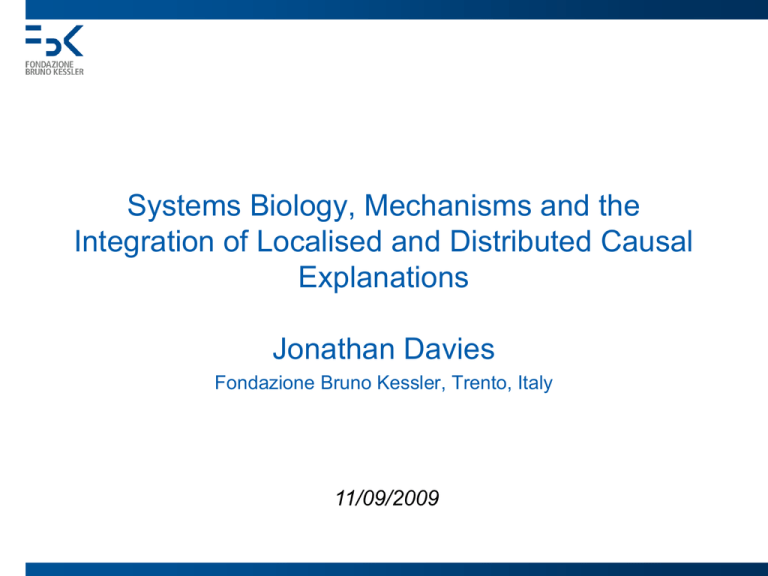Systems Biology
advertisement

Systems Biology, Mechanisms and the Integration of Localised and Distributed Causal Explanations Jonathan Davies Fondazione Bruno Kessler, Trento, Italy 11/09/2009 Introduction • Localised Causal Explanations (LCEs) in biology – Operon model of gene regulation • Distributed Causal Explanations (DCEs) in biology – Stuart Kauffman’s model of gene regulatory networks • Systems Biology (SB) and the integration of LCEs and DCEs • Against the holism/reductionism dichotomy LCEs in (molecular) biology • Identification of locus (loci) of control • If multiple loci of control, separate and assign functional/causal roles (decomposition and localisation) • Functional/causal role of component accounted for in terms of intrinsic properties • “…the protein inserts into the major groove of the DNA helix and makes a series of molecular contacts with the base pairs. The protein forms hydrogen bonds, ionic bonds, and hydrophobic interactions with the edges of the bases […] many of the proteins responsible for gene regulation contain one of several particularly stable folding patterns. These fit into the major groove of the DNA double helix” (Alberts et al. 2004 pp.271-2). DCEs in Biology • No functional decomposition possible • “The hallmark of these cases is that, given a principled structural analysis, the activities of the parts seem to be different in kind from […] those performed by the whole.” (Bechtel and Richardson 1993) • Component activities and relations “described” with formal (mathematical) model Gene regulatory network stability • • • • Network consists of simple nodes (2 possible states) Binary interactions between nodes State transitions Boolean operations With network connectivity (K) close to 2 network encounters stable cycles • Individual node functions not dependent on intrinsic properties of nodes • No functional modules • “Unlike complex systems of simple elements, in which functions emerge from the properties of the networks they form rather than from any specific element, functions in biological systems rely on a combination of the network and specific elements involved” (Kitano 2002 p.206) • “Heterogeneity in biological systems is not just a complication added on top of essential properties, it is constitutive of these essential properties … Heterogeneity is the stuff out of which life evolved […] to ignore [it] is to risk exactly the kind of biological irrelevance that has historically been the fate of so many mathematical models in biology” (Keller 2006 p.8-9). Systems Biology (SB) Two streams • Pragmatic – Molecular biology on a larger scale. Explanatory strategy unchanged. Continued commitment to the adequacy of (mechanistic) LCEs. • Systems Theoretic – Qualitative change incorporating the integration of formal models and molecular data. SB and the integration of LCEs and DCEs • Grounding the theoretic models in the molecular detail (Kitano) • Integration of data-rich fields with data-poor modeling strategies informed by “higher-level” theories (Krohs & Callebaut) • Iterative spiral of observation and theoretical refinement (Westerhoff and Kell) Five Stage SB Strategy 1. Define all of the components of the system, using prior molecular and biochemical knowledge to formulate an initial (potentially very rough) model (in silico). 2. Systematically perturb and monitor components of the model system and observe (measure) corresponding model responses (globally and of other components). 3. Reconcile experimentally observed responses in vitro or in vivo with those predicted by the model. 4. Design and perform new perturbation experiments to distinguish between multiple or competing model hypotheses. 5. Repeat steps 2 to 4. (Ideker et al. 2001) Conclusions • LCEs and DCEs not a dichotomy but extremes on a continuum of explanatory strategies • DCEs need not be holist or non-mechanistic • Biological systems characterised by components, mechanisms and processes of variable modes of interaction and degrees of context sensitivity • Focus on the spatio-temporal distribution of causal element in system facilitates a better understanding of mechanistically explicable emergent phenomena 12 Bibliography Alberts B. et al. (2004) Essential Cell Biology Garland Science (New York) Barabási A. and Oltvai Z. (2004) “Network Biology: Understanding the Cell’s Functional Organization” Nature Reviews, Genetics 5, 101-113 Bechtel W. and Richardson R.C. (1993) Discovering Complexity: Decomposition and Localisation as Strategies in Scientific Research Princeton University Press (available at http://mechanism.ucsd.edu/~bill/discoveringcomplexity.html) Boogerd F.C., Bruggeman F.J., Hofmeyr J.S., Westerhoff H.V. (eds) (2007) Systems Biology: Philosophical Foundations Elsevier (Amsterdam) Burian R.M. and Richardson R.C. (1990) “Form and Order in Evolutionary Biology: Stuart Kauffman’s Transformation of Theoretical Biology” Proceedings of the Biennial Meeting of the PSA 1990 Symposia and Invited Papers 267-287 Cornish-Bowden A. (2006) “Putting the systems back into systems biology” Perspectives in Biology and Medicine 49 (4) 475-489 Glennan S. (2002) “Rethinking Mechanistic Explanation” Philosophy of Science 69 (3) S342- S353 Keller E.F. (2006) “Systems Biology and the Search for General Laws” Unpublished Manuscript Bibliography Kitano H. (2002) “Computational systems biology” Nature 420, 206-210 Machamer P., Darden L., Craver C.F. (2000) “Thinking About Mechanisms” Philosophy of Science 67 (March 2000) 1-25 Mesarovic M.D., Sreenath S.N. and Keene J.D. (2004) “Search for organising principles: understanding in systems biology” Systems Biology 1 (1) O’Malley M.A. & Dupré J. (2005) “Fundamental Issues in Systems Biology” BioEssays 27, 1270-1276 Oyama, Griffiths and Gray (eds) (2001) Cycles of Contingency: Developmental Systems and Evolution MIT Press (Massachusetts, London) Salmon W.C. (1998) Causality and Explanation Oxford University Press (Oxford, New York) Von Bertalanffy (1950a) “An outline of General Systems Theory” The British Journal for the Philosophy of Science 1 (2) 134-165 Webster G. and Goodwin B.C. (1996) Form and Transformation: Generative and Relational Principles in Biology Cambridge University Press (Cambridge)


